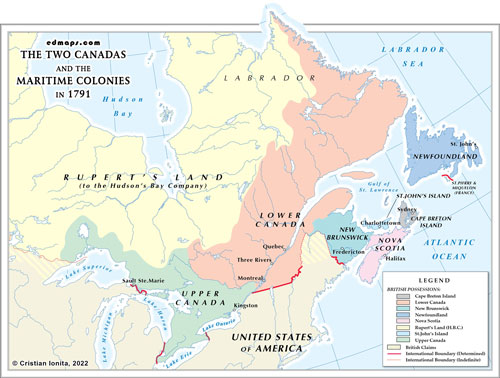The Two Canadas and the Maritime Colonies in 1791

The Two Canadas and the Maritime Colonies in 1791
In 1791, significant changes were made to the political and administrative divisions of British North America, particularly concerning the Canadas and the Maritime Colonies. Here's an overview of the status of these regions in 1791:
The Canadas
Province of Quebec: The Province of Quebec was established by the British Royal Proclamation of 1763, following the Treaty of Paris that ended the French and Indian War. In 1791, the province was divided into two separate entities:
Lower Canada: Lower Canada encompassed the predominantly French-speaking areas of present-day Quebec. The predominantly French population and civil law traditions were maintained in this division.
Upper Canada: Upper Canada referred to the English-speaking areas of present-day Ontario. It attracted loyalists who fled the American Revolutionary War and sought British governance and institutions.
The Maritime Colonies
Nova Scotia: In 1784, Britain split the old colony of Nova Scotia into three colonies: Cape Breton Island, New Brunswick and Nova Scotia. This new colony of Nova Scotia was primarily English-speaking, but with significant Acadian and Indigenous populations. Halifax served as the main administrative center.
Cape Breton Island: A separate colony after 1784, Cape Breton Island had its capital at Sydney..
New Brunswick: A separate colony after 1784, New Brunswick had a significant Loyalist population. Its capital was at Fredericton (the former Fort Anne).
St. John's Island: The island was administered as part of the colony of Nova Scotia, until it was split into a separate colony in 1769. Its capital was at Charlottetown
Newfoundland: St. John's, its capital, is the oldest city in Canada and the oldest continuously settled location in English-speaking North America.
These political divisions in 1791 reflected efforts by the British government to accommodate the linguistic and cultural differences of the populations in the region. The division into Lower Canada (Quebec) and Upper Canada (Ontario) marked an important step toward recognizing and addressing the distinct interests and needs of the French-speaking and English-speaking populations.
Over time, these divisions would undergo further changes and evolve into the provinces and territories that make up modern-day Canada.









